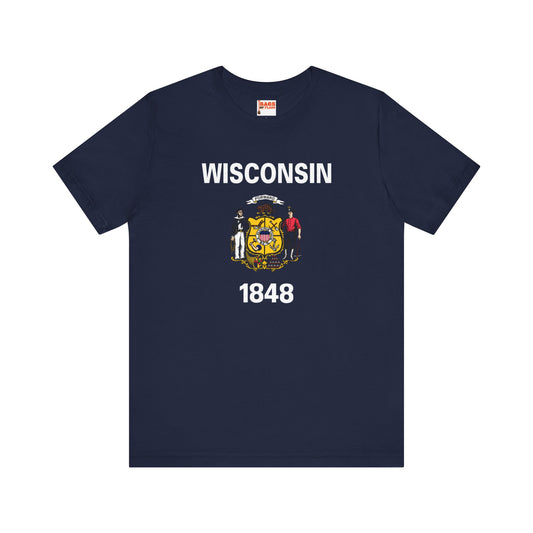-
Wisconsin Pillow
Regular price $22.65 USDRegular priceUnit price / per -
Wisconsin Mug
Regular price $11.65 USDRegular priceUnit price / per -
Wisconsin Trucker Cap
Regular price $14.90 USDRegular priceUnit price / per -
Wisconsin Leather Patch Hat
Regular price $18.85 USDRegular priceUnit price / per -
Wisconsin Backpack
Regular price $59.79 USDRegular priceUnit price / per -
Wisconsin Inspired Sweatshirt
Regular price $34.15 USDRegular priceUnit price / per -
Wisconsin Flag Sweatshirt
Regular price $34.15 USDRegular priceUnit price / per -
Wisconsin Sweatshirt
Regular price $34.15 USDRegular priceUnit price / per -
Wisconsin Hoodies
Regular price $34.40 USDRegular priceUnit price / per -
Wisconsin T-shirts
Regular price $22.79 USDRegular priceUnit price / per -
Wisconsin Flag Hoodies
Regular price $34.40 USDRegular priceUnit price / per -
Wisconsin Inspired Hoodie
Regular price $34.40 USDRegular priceUnit price / per -
Wisconsin Inspired T-shirt
Regular price $22.79 USDRegular priceUnit price / per -
Wisconsin Flag T-shirts
Regular price $22.79 USDRegular priceUnit price / per
Collection: US State: Wisconsin WI flag
The Wisconsin flag symbolizes pride and identity for the state's residents and has a rich history and deep meaning. From its adoption to current controversies surrounding its use, the flag of Wisconsin has played a significant role in the state's culture and heritage.
Overview of the Wisconsin Flag's Design and Colors

The flag of Wisconsin presents a striking visual with a rich navy blue background, serving as a canvas for the state's coat of arms. At the heart of the flag is a vibrant depiction of Wisconsin's diverse heritage and economic foundations. The state's coat of arms is central to the design, which portrays a sailor and a miner flanking a shield. This shield is segmented into four parts, each illustrating different aspects of Wisconsin's economy: agriculture, mining, manufacturing, and navigation. Crowning the shield is the state animal, the badigeon, symbolizing perseverance and hard work.
Below the shield, a white banner bears the state motto, "Forward," a testament to Wisconsin's ongoing progress and ambitious spirit. The coat of arms is surrounded by thirteen stars, representing Wisconsin's status as the 30th state to join the Union but honoring the original thirteen colonies. The year of statehood, 1849, is prominently displayed, anchoring the flag in a historical context. Blue, white, and gold provide a visually appealing contrast. It imbues the flag with symbolic meanings of loyalty, purity, and prosperity, weaving together a narrative of Wisconsin's past, present, and aspirations for the future.
Historical Context Surrounding the Flag
Initially introduced during the tumultuous Civil War in 1863, the Wisconsin flag has undergone several transformations to reach its present form. This period marked a national conflict and a moment of significant identity formation for Wisconsin. The first version of the flag aimed to distinguish Wisconsin troops on the battlefield with a symbol of their home state.
It wasn't until 1913, fifty years later, that the flag was redesigned to incorporate the state's coat of arms, adding layers of local symbolism and pride. In 1979, further amendments were made to ensure the flag's distinctiveness, including adding "WISCONSIN" and "1848" to the design, cementing the state's identity and heritage within its visual representation. These modifications reflect an evolving narrative of what the state stands for, marrying its rich history with the aspirations and values of its people over time. The evolution of the Wisconsin flag is a testament to the state's resilience and adaptive spirit, showcasing a journey of growth and redefinition through the ages.
Symbolism Encoded in the Flag's Design
At the core of the Wisconsin flag's design lies a deep well of symbolism that captures the essence of the state's identity and values. The coat of arms, prominently featured, acts as a narrative tableau for Wisconsin's diverse economic and cultural background. Flanked by a sailor and a miner, the emblem pays homage to the pivotal industries shaping the state's history and economy.
These figures stand guard over a shield divided into quadrants, each representing a cornerstone of Wisconsin's economic foundation: the plow for agriculture, the pick and shovel for mining, an arm and hammer for manufacturing, and an anchor for navigation, symbolizing the state's connection to both its inland waterways and the Great Lakes.
The badger's presence atop the shield nods to Wisconsin's nickname, "The Badger State," a moniker derived from early 19th-century miners. This animal, known for its tenacity and dynamic nature, serves as an emblem of the hardworking spirit of Wisconsin's people. The state motto, "Forward," on a white ribbon underscores a collective ambition towards progress and improvement, reflecting a forward-thinking mindset intricately woven into the state's fabric. The thirteen stars encircling the coat of arms honor Wisconsin's position as the 30th state and pay tribute to the original thirteen colonies, symbolizing unity and heritage. Together, these elements tell a story of resilience, innovation, and unwavering progress that defines Wisconsin.
The Current Relevance of the Wisconsin Flag
In contemporary times, the Wisconsin flag is prominently displayed at state government buildings, featured during military ceremonies, and waved at various national events, symbolizing a collective state identity and pride. Beyond its traditional uses, the flag has become a focal point in discussions about state symbols and their meanings in modern society. Critiques of the flag's design and calls for updates have emerged, mirroring broader national conversations about how historical symbols fit within today's cultural landscape.
These debates have engaged communities across Wisconsin, from lawmakers to everyday citizens, reflecting diverse opinions on whether the flag should evolve or remain unchanged. The discussions underscore the dynamic relationship between historical symbols and current societal values, illustrating the ongoing relevance of the Wisconsin flag as not just a symbol of the state’s past but as a living part of its present and future discourse.
Additional Facts and Protocols
When displaying the Wisconsin flag alongside the national flag, it should be placed to the observer's left when the poles are equal in height. If the flags are flown from adjacent staffs, the flag of the United States should be hoisted first and lowered last. This is following the respect traditionally afforded to the national flag. Furthermore, when displayed with a collection of state flags, it's customary for the Wisconsin flag to be arranged in the order of statehood, with Wisconsin's entry as the 30th state. The proper way to fold the Wisconsin flag follows a triangular pattern similar to the American flag, symbolizing respect and care for the flag.
An intriguing protocol related to the flag involves its use in state ceremonies, where it must be displayed prominently, reflecting its status as a symbol of state sovereignty and pride. Another lesser-known aspect is that the state government defines the specific shades of blue and gold used in the flag, ensuring consistency across all public representations. These guidelines and facts not only enrich the narrative of the Wisconsin flag but also embody the respect and reverence with which the people of Wisconsin regard it.




























